Abstract
Biological invasions are considered among the largest threats to native biodiversity. The Mediterranean Sea, connecting the Indo-Pacific and Atlantic oceans, is characterized as a global marine invasion hotspot, due to a multitude of human pathways and vectors such as shipping, aquaculture, tourism, and the opening of the Suez Canal, which have led to the introduction of nearly 700 alien species into the Mediterranean Sea. Among the species introduced, the lionfish Pterois miles could be considered the fastest spreading invasive fish species of the last decade (2012–2022) and has been recorded in all countries of the eastern Mediterranean Sea, reaching as far north as Croatia. Here, we present a Bayesian additive regression tree modelling framework for an updated species distribution modelling invasion map under current and future climate conditions. All climate uncertainty sources have been used, as these are available from the Bio-Oracle, the unique marine predictors database. Important outputs of the current approach are the model’s inadequacy to accurately predict the most recent expansion of species in the Adriatic Sea, and the uncertainty estimation, that are high in areas with confirmed occurrence of individuals, in simulations that can help the decision makers and policy officers understand model limitations and take more informed actions.
1. Introduction
Alien species, aided by human agencies, managed to overcome physical barriers and colonize new regions beyond their natural range [1,2]. Every year, new species move and establish populations that can become problematic for native species and habitats, causing severe economic impacts [3,4], due to fast adaptation and the absence of predators that control the population [5] in their native distribution range. On the other hand, the inclusion of the species in the local cuisine due to the plentiful availability as a food source could act as a mitigation action of population control [6]. Both lionfish species, Pterois miles (Linnaeus, 1758) and Pterois volitans (Bennett, 1828), have shown adaptability to quickly establish populations in new environments as revealed by populations in the Mediterranean and the Caribbean Sea. Lionfish are native to the Pacific and Indian Ocean, respectively [7]. During the last three decades, the Pterois complex has displayed one of the most disruptive marine biological invasions worldwide [8,9], rapidly spreading throughout the tropical and subtropical coasts of the western Atlantic, the Gulf of Mexico and the Caribbean Sea [10,11,12].
This unprecedented invasion extended across a wide range of natural habitats [13,14,15], severely impacting coastal biodiversity as well as ecosystem processes and functions [3,16,17]. Recently, a new lionfish invasion has begun in the Mediterranean Sea. This invasion started in 2012, when two individuals of the common lionfish P. miles were recorded from the Lebanese coasts [18]. Since then, the population of P. miles has rapidly increased and spread westwards, reaching Sicily and Tunisia [19,20,21]. Molecular analyses revealed that the invading P. miles population is of Red Sea origin founded by individuals immigrating through the Suez Canal [22] in multiple introductions [23]. There are serious concerns about the potential ecological impact of this incipient invasion, since the Mediterranean Sea is a biodiversity hotspot and the world’s most invaded marine region [24,25].
Predicting P. miles’ potential geographic distribution in the Mediterranean Sea under current and future environmental conditions, based on the Intergovernmental Panel on Climate Change (IPCC) climate change scenarios, is among the most urgent research objectives, with concrete applications in conservation, early warning, and invasive-species management. Climate change is expected to further change the geographical distribution of non-indigenous species [26]. Alien species are generally considered to be more likely to cope with climate change allowing them to expand into new regions, as they are generalists with broader climate tolerance [27]. Although there is limited evidence of the current impact of climate change on the distribution of alien species, it is often suggested that climate change is one of the major contributors to future competition [28,29]. The rate of tropical alien species immigration from the Red Sea to the Mediterranean Sea correlates with gradual but steady changes in climatic variables in the Mediterranean region [30]. As parameters of the Mediterranean waters become more similar to those of the Red Sea, aquatic species with analogous physiological response are now able to cross the Suez Canal, which previously acted as a natural barrier, and inhabit the eastern Mediterranean basin [1,31]. The rate of spread of some NIS of Red Sea origin (i.e., Fistularia commersonni; 489 km year−1) is significantly higher than from natives (Hiddink et al., 2012) or other biological characteristics [32].
The current work uses a Bayesian framework for the distribution modelling of the lionfish P. miles in the Mediterranean Sea under current and future marine climate conditions, expanding the previous work by Poursanidis et al. [33] and provides uncertainty in the predictions as a spatial explicit information, usefully to be incorporated in the process of decision making for targeted activities and robust decisions [1]. The use of uncertainty during modelling processes, where the results will be incorporated in decision making process, is an important step towards clear and informative science for the stakeholders [34].
2. Materials and Methods
Several modelling approaches are available [35], depending on the environmental questions and available data. Here we modelled the realized climatic niche of the taxon under study by combining the available occurrence data with current environmental predictors with ‘embarcadero’ [36] R package. We used Bayesian additive regression trees (BARTs) and functions from the ‘embarcadero’ R package. BARTs are a classification tree method defined by a prior distribution and a likelihood for returning occurrence predictions that enables the quantification of uncertainty around the predictions and the estimation of the marginal effects of the covariates [37].
We thereafter generated presence/absence datasets following available recommendations from other studies [38,39] for the taxon under study. We evaluated our model’s performance based on seven metrics [AUC, Sorensen’s index, TSS, Brier score, Cohen’s kappa, Continuous Boyce Index (CBI), Somer’s D] [40,41,42,43,44,45] and we used a repeated split-sampling approach to evaluate our models [46]. The metrics estimation used was done using functions from the following R packages: ‘CalibratR’ 0.1.2, ‘DescTools’ 0.99.40, ‘ecospat’ 3.2, ‘enmSdm’ 0.5.3.2, ‘Metrics’ 0.1.4, ‘MLmetrics’ 1.1.1 and ‘modEvA’ 2.0 [47,48,49,50,51,52]. We reconstructed the potential suitable area of P. miles under current and future climate conditions, using the ‘predict2.bart’ function, excluding any predictors that were not included in our fine-tuned model. Finally, the importance of each variable retained in our final model was estimated using the ‘varimp’ function of the ‘embarcadero’ R package.
The environmental data are based on oceanographic variables from the Bio-Oracle database v.2.1 [53] at 8 km pixel size. From the available dataset we used data that already used by D’Amen on Mediterranean Invasive Species and projections [54]. These are pH, salinity (mean and range), sea surface temperature (mean and range), and mean primary productivity. For the climate change predictions, we used the period 2040–2050 with the RCP2.6, RCP4.5, RCP6.0 and RCP8.5. The RCP2.6, a peak-and-decline scenario ending on very low greenhouse gas concentration levels by the end of the 21st century, the RCP4.5 and RCP6.0 where concentration levels stabilize, and the RCP8.5, a scenario of increasing emissions over time leading to high concentration levels of greenhouse gases. The occurrence data used were derived from both the native and invaded area, following the approach in [33] (see Figure S1 in the publication); these were derived from the available literature data [55], the latest GBIF data [56], along with data from the archive of iSea, a Greek Environmental Organization (personal communication).
3. Results and Discussion
Species distribution modelling using Bayesian additive regression trees has been used to identify the potential distribution of P. miles in the Mediterranean Sea, along with a prediction for the period 2040–2050 under four RCPs (RCP26, RCP45, RCP60 and RCP85). For the current timeframe, we find the potential distribution area to be limited to areas already known in the eastern Mediterranean Sea, with very few medium value spots of potential occurrence in South Sicily and in Algeria. No further expansion is predicted in the western and northern Mediterranean Sea, or the Adriatic. This contradicts the recent sighting of a juvenile P. miles individual (13 cm) in the central Adriatic Sea, in Viz Island [57] and references therein for lionfish sightings in the southern Adriatic Sea. Our simulations predict that the Adriatic Sea is unfavorable for the establishment of a sustainable population under current and projected climate conditions.
The model statistics regarding the accuracy based on multiple metrics is summarized in Table 1 and shows that it has excellent performance across all calculated indices. The performance of our model was exceptionally good, as evidenced by the very low Brier score, i.e., a proper classification metric that is unaffected by prevalence [58]. From the metrics of the model evaluation (Table 1), the model with high accuracy results was the one based on the Boyce index, i.e., a preferred method for the validation of continuous prediction layers, but also the TSS statistic, i.e., which requires the binarization of the continuous layer into a yes/no approach following thresholds that are defined by the coefficients of the model.

Table 1.
Accuracy metrics and indices for the Species Distribution Model of Pterois miles in the Mediterranean Sea.
The outputs for each period from the current environmental data to the IPCC RCP climate change scenario and its uncertainty estimation is provided in Figure 1, Figure 2, Figure 3, Figure 4 and Figure 5. Prediction uncertainty was generally low (Figure 6); however, certain areas in the Mediterranean Sea show high uncertainty. These areas are:
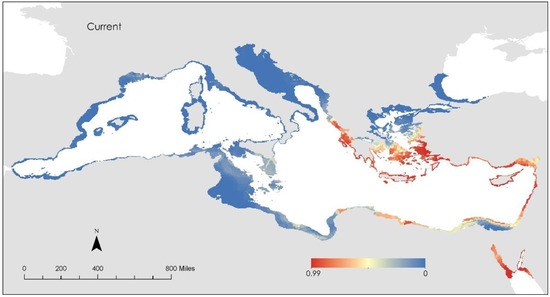
Figure 1.
Lionfish potential distribution under current conditions (2000–2014).
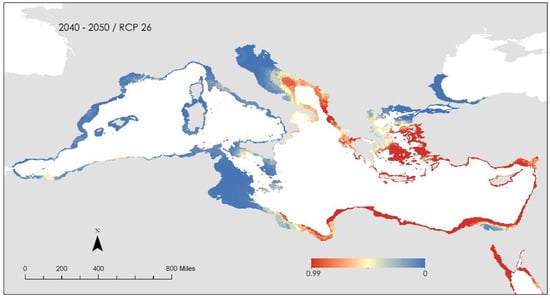
Figure 2.
Lionfish potential distribution under RCP26 for the period 2040–2050.
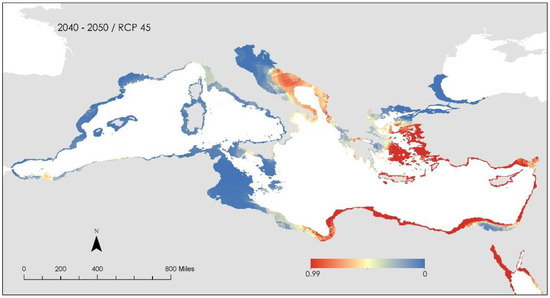
Figure 3.
Lionfish potential distribution under RCP45 for the period 2040–2050.
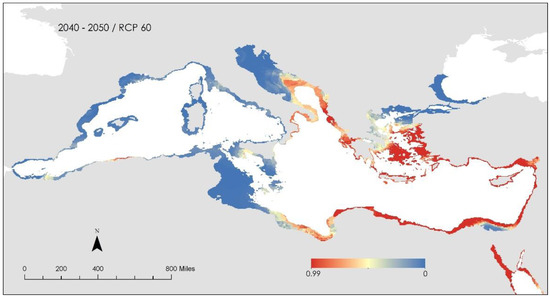
Figure 4.
Lionfish potential distribution under RCP60 for the period 2040–2050.
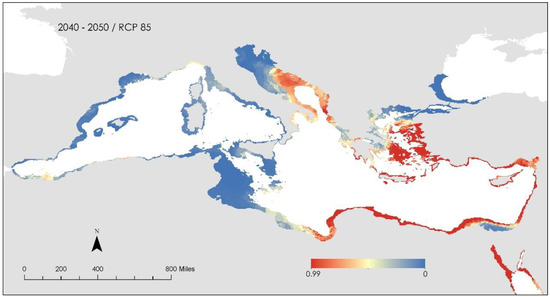
Figure 5.
Lionfish potential distribution under RCP85 for the period 2040–2050.
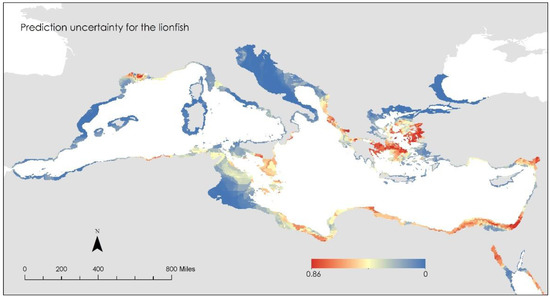
Figure 6.
Lionfish prediction uncertainty.
- i.
- the Patraikos Gulf, Greece
- ii.
- the Saronikos Gulf extending to the Northern Cyclades, Greece
- iii.
- the area surrounding Chios and Skyros islands, Greece
- iv.
- the area surrounding Corfu Island, Greece
- v.
- South of Sicily, Italy
- vi.
- the Gulf of Lion, France and
- vii.
- Certain scattered areas along the North African coast.
Prediction uncertainty was also high in the Suez Canal, and this is probably attributed to the very high effect of salinity on habitat suitability of P. miles. The latter was dealt by setting to zero any cells with high uncertainty values (i.e., with uncertainty values equal to or higher than the 90% uncertainty). Future projections of P. miles in the Mediterranean Basin revealed absence from the Ionian Sea (from south of Corfu to the NW coasts of Peloponnese), as well as from areas off the coasts of southern Peloponnese and Kythera. The range expansion of P. miles in the Mediterranean Basin is expected in the following areas:
- i.
- The area around Lemnos Island, Greece
- ii.
- The area around the Nile Delta, Egypt
- iii.
- The area around Benghazi, Libya
- iv.
- The area around Algeria
The results from the climate change scenario model gave interesting insights for the Mediterranean Sea. Under the RCP26 and the other RCPs for the timeframe from 2040 to 2050 we produced projection to selected areas in the Adriatic Sea, mostly in the southern parts of it, where records of the species are already available [57], but also for the north-west Africa, Morocco and Algeria and the Gulf of Genoa. We find that salinity plays important role for the distribution of species and the climate change scenarios, a finding that also other studies have concluded [33,57].
Any prediction based on the current available data has to be used and interpreted with caution since all data are based on the IPCC report of 2014. Recently, the new Climate Change Report of 2021, the Physical Science has been released [58], along with the Climate Change 2022: Impacts, Adaptation and Vulnerability [59] (IPCC, 2022). It introduces the new Shared Socioeconomic Pathways (SSPs), which include breakthrough improvements in the projections and the way they introduce how broad socioeconomic trends could shape future society. These are intended to span the range of plausible futures. They include: a world of sustainability-focused growth and equality (SSP1); a “middle of the road” world where trends broadly follow their historical patterns (SSP2); a fragmented world of “resurgent nationalism” (SSP3); a world of ever-increasing inequality (SSP4); and a world of rapid and unconstrained growth in economic output and energy use (SSP5) [60].
However, for the needs of the current work, the available environmental data include climate change scenarios under the Representative Concentration Pathway (RCP); a greenhouse gas concentration (not emissions) trajectory adopted by the IPCC. Four pathways were used for climate modeling and research for the IPCC fifth Assessment Report (AR5) in 2014. The pathways describe different climate futures, all of which are considered possible depending on the volume of greenhouse gases (GHG) emitted in the years to come.
Figure 1, Figure 2, Figure 3, Figure 4 and Figure 5 provide the results of the model under current climate and future climate scenarios as described above. Sharp changes are observed in the South Adriatic Sea, Central Mediterranean Sea in the straits of Sicily and in some scattered areas in the coastal zone of Morocco/Algeria. However, the uncertainty of the model as it is provided by Figure 6, for the current distribution of the lionfish, provide further insight into the model robustness. Uncertainty is a dimensionless value, an information that provide to the end user how certain is the model at a given area, how confident information is provided and by that how much trustiness can laid to this information. Low values, close to zero, shows that the results are robust, and the end user can trust them for further planning in conservation, removal, designation, spatial planning etc. In the opposite direction, high values shows that the model was not able to understand the conditions that, in our case, the lionfish will face during the spatial expansion and says that even if predictions shows that it might be there, further information on survival, reproduction and establishment of viable populations with large numbers of individuals are not secured. For example, even if we have records from South Sicily or even quite recent from Vis Island in Croatia Sea, no further insights on the population status, the expansion of them and the density are available, showing that these populations might not be able to reproduce due to low temperatures during the winter period in combination with other oceanographic and biological factors.
The used data came from a unique database of marine environmental predictors, well designed, and prepared in analytical workflows for Species Distribution Modelling. The dataset has been prepared followed a standardized approach to deliver SDM-ready data for use by the scientific community for species and ecosystem modelling. However, the update of them using new models and algorithms along with the utilization of the full archive of any available observations from satellites to in situ monitoring systems is lacking behind. Uncertainty is introduced in our study from the definition of the “current” period which is up to 2014; the lionfish invasion appears to start in 2012 and the climax of spread has been reached until 2020. The environmental data does not sufficiently cover this timeframe, in which changes in oceanographic characteristics, such as temperature raise and marine heatwaves along with salinification of the Levantine basin which often coincides with a freshening of the western Ionian Sea [61,62], are not included either in the environmental data nor in the RCP layers. Further, with the publication of the new IPCC report [60], RCPs have been substituted by the SSPs, the Shared Socioeconomic Pathways. No dataset that is “camera-ready” for use in Species Distribution Modelling has made substantial updates to cover the “real” current oceanographic characteristics nor the inclusion of SSPs instead of the previous used RCPs. It is expected that such improvements will substantially improve the modelling activities for Invasive Alien Species, allowing for more robust results and actual use of the information in targeted activities in the domain of conservation, spatial planning, and confrontation.
The designation of a platform where, frequently or after a user’s request, environmental predictors will be calculated and prepared for use in environmental modelling will become an important asset and ally towards tackling environmental and societal issues like the Invasive Alien Species. By that, improvement of the current knowledge and more robust projections with their uncertainties will create high quality data to be used in modelling and the process of transparent decision making for management of environmental problems [63,64]. Uncertainty in Species Distribution Modelling is among the priorities for the systematic incorporation into new workflows aimed at support in decision making [65]. However, due to the complexity of the Bayesian frameworks that can provide this important information along with the misinterpretation of uncertainty information and lack of experience in interpreting that into the conceptual understanding of decision makers, it is rarely used in invasive alien species modelling.
The current work uses an updated and modern approach to quantify and map the potential distribution of the lionfish in the Mediterranean Sea using standardized environmental data in a Bayesian modelling framework that allows the calculation of the uncertainty. This information can support targeted activities and informative decisions incorporating risks. Decision-makers with experience in the use of such information can benefit in the planning of targeted activities by estimating the costs and probability of success balanced between high probabilities and low uncertainties and vice versa. It is expected in the next decade that such approaches will become a standard workflow in species distribution models, from where the results will have a practical use in conservation and planning for the protection or eradication of invasive alien species.
Author Contributions
Conceptualization, D.P.; methodology, D.P., K.K. and S.K.; formal analysis, D.P., K.K.; data curation, D.P., K.K. and V.M.; writing—original draft preparation, All Authors; supervision, D.P.; project administration, D.K.; funding acquisition, D.K. and N.C. All authors have read and agreed to the published version of the manuscript.
Funding
This research was funded by the LIFE financial instrument of the European Union—RELIONMED project [Grant Agreement LIFE16 NAT/CY/000832].
Institutional Review Board Statement
Not applicable.
Informed Consent Statement
Not applicable.
Data Availability Statement
Not applicable.
Conflicts of Interest
The authors declare no conflict of interest.
References
- Katsanevakis, S.; Moustakas, A. Uncertainty in Marine Invasion Science. Front. Mar. Sci. 2018, 5, 38. [Google Scholar] [CrossRef] [Green Version]
- Kalogirou, S. Alien Fish Species in the Eastern Mediterranean Sea: Invasion Biology in Coastal Ecosystems. Ph.D. Thesis, University of Gothenburg, Gothenburg, Sweden, 2011. [Google Scholar]
- Ballew, N.G.; Bacheler, N.M.; Kellison, G.T.; Schueller, A.M. Invasive lionfish reduce native fish abundance on a regional scale. Sci. Rep. 2016, 6, 32169. [Google Scholar] [CrossRef] [PubMed]
- Kalogirou, S. Ecological characteristics of the invasive pufferfish Lagocephalus sceleratus (Gmelin, 1789) in Rhodes, Eastern Mediterranean Sea. A case study from Rhodes. Mediterr. Mar. Sci. 2013, 14, 251–260. [Google Scholar] [CrossRef] [Green Version]
- Ulman, A.; Kalogirou, S.; Pauly, D. The Dynamics of Maximum Lengths for the Invasive Silver-Cheeked Toadfish (Lagocephalus sceleratus) in the Eastern Mediterranean Sea. J. Mar. Sci. Eng. 2022, 10, 387. [Google Scholar] [CrossRef]
- CAR-SPAW-RA. 2022. Available online: https://www.car-spaw-rac.org/?Lionfish-The-lionfish-in-its-native-range-brief-description-of-its-biology-and#:~:text=Although%20lionfish%20is%20a%20food,endangered%20in%20their%20native%20range (accessed on 23 March 2022).
- Kulbicki, M.; Beets, J.; Chabanet, P.; Cure, K.; Darling, E.; Floeter, S.R.; Galzin, R.; Green, A.; Harmelin-Vivien, M.; Hixon, M.; et al. Distributions of Indo-Pacific lionfishes Pterois spp. in their native ranges: Implications for the Atlantic invasion. Mar. Ecol. Prog. Ser. 2012, 446, 189–205. [Google Scholar] [CrossRef] [Green Version]
- Albins, M.A.; Hixon, M.A. Invasive Indo-Pacific lionfish Pterois volitans reduce recruitment of Atlantic coral-reef fishes. Mar. Ecol. Prog. Ser. 2008, 367, 233–238. [Google Scholar] [CrossRef]
- Hixon, M.A.; Green, S.J.; Albins, M.A.; Akins, J.L.; Morris, J.A., Jr. Lionfish: A major marine invasion. Mar. Ecol. Prog. Ser. 2016, 558, 161–165. [Google Scholar] [CrossRef] [Green Version]
- Whitfield, P.E.; Gardner, T.; Vives, S.P.; Gilligan, M.R.; Courtenay, W.R., Jr.; Ray, G.C.; Hare, J.A. Biological invasion of the Indo-Pacific lionfish Pterois volitans along the Atlantic coast of North America. Mar. Ecol. Prog. Ser. 2002, 235, 289–297. [Google Scholar] [CrossRef] [Green Version]
- Semmens, B.X.; Buhle, E.R.; Salomon, A.K.; Pattengill-Semmens, C.V. A hotspot of non-native marine fishes: Evidence for the aquarium trade as an invasion pathway. Mar. Ecol. Prog. Ser. 2004, 266, 239–244. [Google Scholar] [CrossRef] [Green Version]
- Johnston, S.J.; Purkis, M.W. Are lionfish set for a Mediterranean invasion? Modelling explains why this is unlikely to occur. Mar. Pollut. Bull. 2014, 88, 138–147. [Google Scholar] [CrossRef]
- Morris, J.A., Jr. (Ed.) Invasive Lionfish: A Guide to Control and Management; Gulf and Caribbean Fisheries Institute: Marathon, FL, USA, 2012. [Google Scholar]
- Albins, M.A.; Hixon, M.A. Worst case scenario: Potential long-term effects of invasive predatory lionfish (Pterois volitans) on Atlantic and Caribbean coral-reef communities. Environ. Biol. Fish 2013, 96, 1151–1157. [Google Scholar] [CrossRef]
- Côté, I.M.; Green, S.; Hixon, M.A. Predatory fish invaders: Insights from the Indo-Pacific lionfish in the western Atlantic and Caribbean. Biol. Conserv. 2013, 164, 50–61. [Google Scholar] [CrossRef]
- Albins, M.A. Invasive Pacific lionfish Pterois volitans reduce abundance and species richness of native Bahamian coral-reef fishes. Mar. Ecol. Prog. Ser. 2015, 522, 231–243. [Google Scholar] [CrossRef] [Green Version]
- Andradi-Brown, D.A.; Vermeij, M.; Slattery, M.; Lesser, M.; Bejarano, I.; Appeldoorn, R.; Goodbody-Gringley, G.; Chequer, A.D.; Pitt, J.M.; Eddy, C.; et al. Large-scale invasion of western Atlantic mesophotic reefs by invasive lionfish potentially undermines culling-based management. Biol. Invasions 2017, 19, 939–954. [Google Scholar] [CrossRef]
- Bariche, M.; Torres, M.; Azzurro, E. The presence of the invasive lionfish Pterois miles in the Mediterranean Sea Mediterr. Mar. Sci. 2013, 14, 292–294. [Google Scholar] [CrossRef]
- Kletou, D.; Hall-Spencer, J.M.; Kleitou, P. Kleitou A lionfish (Pterois miles) invasion has begun in the Mediterranean Sea. Mar. Biodivers. Rec. 2016, 9, 305. [Google Scholar] [CrossRef] [Green Version]
- Dailianis, T.; Akyol, O.; Babali, N.; Bariche, M.; Crocetta, F.; Gerovasileiou, V.; Chanem, R.; Gökoğlu, M.; Hasiotis, T.; Izquierdo-Muñoz, A.; et al. New Mediterranean biodiversity records (July 2016). Mediterr. Mar. Sci. 2016, 17, 608–626. [Google Scholar] [CrossRef] [Green Version]
- Azzurro, E.; Stancanelli, B.; Dimartino, V.; Bariche, M. Range expansion of the common lionfish Pterois miles (Bennett, 1828) in the Mediterranean Sea: An unwanted new guest for Italian waters. BioInvasions. Rec. 2017, 6, 95–98. [Google Scholar] [CrossRef]
- Bariche, M.; Kleitou, P.; Kalogirou, S.; Bernardi, G. Genetics reveal the identity and origin of the lionfish invasion in the Mediterranean Sea. Sci. Rep. 2017, 7, 6782. [Google Scholar] [CrossRef] [Green Version]
- Dimitriou, N.; Chartosia, J.M.; Hall-Spencer, P.; Kleitou, C.; Jimenez, C.; Antoniou, L.; Hadjioannou, D.; Kletou, S. Sfenthourakis Genetic data suggest multiple introductions of the lionfish (Pterois miles) into the Mediterranean Sea. Diversity 2019, 11, 149. [Google Scholar] [CrossRef] [Green Version]
- Coll, M.; Piroddi, C.; Steenbeek, J.; Kaschner, K.; Ben Rais Lasram, F.; Aguzzi, J.; Ballesteros, E.; Bianchi, C.N.; Corbera, J.; Dailianis, T.; et al. The biodiversity of the Mediterranean Sea: Estimates, patterns, and threats. PLoS ONE 2010, 5, e11842. [Google Scholar] [CrossRef] [PubMed] [Green Version]
- Edelist, G.; Rilov, D.; Golani, J.T.; Carlton, E. Spanier Restructuring the sea: Profound shifts in the world’s most invaded marine ecosystem. Divers. Distrib. 2013, 19, 69–77. [Google Scholar] [CrossRef]
- Hellmann, J.J.; Bierwagen, B.G.; Dukes, J.S.; Byers, J.E. Five Potential Consequences of Climate Change for Invasive Species. Conserv. Biol. 2008, 22, 534–543. [Google Scholar] [CrossRef]
- Walther, G.-R.; Roques, A.; Hulme, P.E.; Sykes, M.T.; Pyšek, P.; Kühn, I.; Zobel, M.; Bacher, S.; Botta-Dukát, Z.; Bugmann, H.; et al. Alien species in a warmer world: Risks and opportunities. Trends Ecol. Evol. 2009, 24, 686–693. [Google Scholar] [CrossRef] [PubMed] [Green Version]
- Occhipinti-Ambrogi, A. Global change and marine communities: Alien species and climate change. Mar. Pollut. Bull. 2007, 55, 342–352. [Google Scholar] [CrossRef] [PubMed]
- Bellard, C.; Thuiller, W.; Leroy, B.; Genovesi, P.; Bakkenes, M.; Courchamp, F. Will climate change promote future invasions? Glob. Chang. Biol. 2013, 19, 3740–3748. [Google Scholar] [CrossRef] [PubMed]
- Ben Rais Lasram, F.; Guilhaumon, F.; Mouillot, D. Fish diversity patterns in the Mediterranean Sea: Deviations from a mid-domain model. Mar. Ecol. Prog. Ser. 2009, 376, 253–267. [Google Scholar] [CrossRef] [Green Version]
- Arndt, E.; Schembri, P.J. Common traits associated with establishment and spread of Lessepsian fishes in the Mediterranean Sea. Mar. Biol. 2015, 162, 2141–2153. [Google Scholar] [CrossRef]
- Hiddink, J.G.; Ben Rais Lasram, F.; Cantrill, J.; Davies, A.J. Keeping pace with climate change: What can we learn from the spread of Lessepsian migrants? Glob. Chang. Biol. 2012, 18, 2161–2172. [Google Scholar] [CrossRef]
- Poursanidis, D.; Kalogirou, S.; Azzurro, E.; Parravicini, V.; Bariche, M.; Dohna, H. Habitat suitability, niche unfilling and the potential spread of Pterois miles in the Mediterranean Sea. Mar. Pollut. Bull. 2020, 154, 111054. [Google Scholar] [CrossRef]
- Uusitalo, L.; Lehikoinen, A.; Helle, I.; Myrberg, K. An overview of methods to evaluate uncertainty of deterministic models in decision support. Environmental Modelling and Software 2015, 63, 24–31. [Google Scholar] [CrossRef] [Green Version]
- Guisan, A.; Thuiller, W.; Zimmermann, N. Habitat Suitability and Distribution Models: With Applications in R (Ecology, Biodiversity and Conservation); Cambridge University Press: Cambridge, UK, 2017. [Google Scholar] [CrossRef]
- Carlson, C.J. embarcadero: Species distribution modelling with Bayesian additive regression trees in r. Methods Ecol. Evol. 2020, 11, 850–858. [Google Scholar] [CrossRef]
- Chipman, H.A.; George, E.I.; McCulloch, R.E. BART: Bayesian additive regression trees. Ann. Appl. Stat. 2010, 4, 266–298. [Google Scholar] [CrossRef]
- Barbet-Massin, M.; Jiguet, F.; Albert, C.H.; Thuiller, W. Selecting pseudo-absences for species distribution models: How, where and how many? Methods Ecol. Evol. 2012, 3, 327–338. [Google Scholar] [CrossRef]
- Liu, C.; Newell, G.; White, M. The effect of sample size on the accuracy of species distribution models: Considering both presences and pseudo-absences or background sites. Ecography 2019, 42, 535–548. [Google Scholar] [CrossRef] [Green Version]
- Allouche, O.; Tsoar, A.; Kadmon, R. Assessing the accuracy of species distribution models: Prevalence, kappa and the true skill statistic (TSS). J. Appl. Ecol. 2006, 43, 1223–1232. [Google Scholar] [CrossRef]
- Fielding, A.H.; Bell, J.F. A review of methods for the assessment of prediction errors in conservation presence/absence models. Environ. Conserv. 1997, 24, 38–49. [Google Scholar] [CrossRef]
- Hirzel, A.H.; Le Lay, G.; Helfer, V.; Randin, C.; Guisan, A. Evaluating the ability of habitat suitability models to predict species presences. Ecol. Modell. 2006, 199, 142–152. [Google Scholar] [CrossRef]
- Liu, C.; White, M.; Newell, G. Measuring and comparing the accuracy of species distribution models with presence-absence data. Ecography 2011, 34, 232–243. [Google Scholar] [CrossRef]
- Liu, C.; Newell, G.; White, M. On the selection of thresholds for predicting species occurrence with presence-only data. Ecol. Evol. 2016, 6, 337–348. [Google Scholar] [CrossRef] [Green Version]
- Sofaer, H.R.; Hoeting, J.A.; Jarnevich, C.S. The area under the precision-recall curve as a performance metric for rare binary events. Methods Ecol. Evol. 2019, 10, 565–577. [Google Scholar] [CrossRef]
- Leroy, B.; Delsol, R.; Hugueny, B.; Meynard, C.N.; Barhoumi, C.; Barbet-Massin, M.; Bellard, C. Without quality presence–absence data, discrimination metrics such as TSS can be misleading measures of model performance. J. Biogeogr. 2018, 45, 1994–2002. [Google Scholar] [CrossRef]
- Hammer, B.; Frasco, M. Metrics: Evaluation Metrics for Machine Learning, R Package Version 0.1.4 2018. 2018. Available online: https://cran.r-project.org/web/packages/Metrics/index.html (accessed on 25 March 2022).
- Schwarz, J.; Heider, D. GUESS: Projecting machine learning scores to well-calibrated probability estimates for clinical decision-making. Bioinformatics 2019, 35, 2458–2465. [Google Scholar] [CrossRef] [PubMed]
- Signorell, A.; Aho, K.; Anderegg, N.; Aragon, T.; Arppe, A.; Baddeley, A.; Bolker, B.; Caeiro, F.; Champely, S.; Chessel, D. DescTools: Tools for Descriptive Statistics, R Package Version 0.99-40 2021. 2021. Available online: https://cran.r-project.org/web/packages/Metrics/index.html (accessed on 25 March 2022).
- Smith, A.B. enmSdm: Tools for Modeling Species Niches and Distributions, R Package Version 0.5.1.5 2020. 2020. Available online: https://cran.r-project.org/web/packages/Metrics/index.html (accessed on 25 March 2022).
- Yan, Y. MLmetrics: Machine Learning Evaluation Metrics, R Package Version 1.1.1 2016. 2016. Available online: https://cran.r-project.org/web/packages/Metrics/index.html (accessed on 25 March 2022).
- Assis, J.; Tyberghein, L.; Bosch, S.; Verbruggen, H.; Serrão, E.A.; De Clerck, O.; Tittensor, D. Bio-ORACLE v2.0: Extending marine data layers for bioclimatic modelling. Global Ecol. Biogeogr. 2018, 27, 277–284. [Google Scholar] [CrossRef]
- D’Amen, M.; Azzurro, E. Lessepsian fish invasion in Mediterranean marine protected areas: A risk assessment under climate change scenarios. ICES J. Mar. Sci. 2020, 77, 388–397. [Google Scholar] [CrossRef]
- Dimitriadis, C.; Galanidi, M.; Zenetos, A.; Corsini-Foka, M.; Giovos, I.; Karachle, P.K.; Fournari-Konstantinidoy, I.; Kytinou, E.; Issaris, Y.; Azzurro, E.; et al. Updating the occurrences of Pterois miles in the Mediterranean Sea, with considerations on the thermal boundaries and future range expansion. Mediterr. Mar. Sci. 2020, 21, 62–69. [Google Scholar] [CrossRef]
- GBIF. 2021. GBIF.org (5 March 2021) GBIF Occurrence Download. Available online: https://doi.org/10.15468/dl.gmy9g2 (accessed on 5 March 2021).
- Dragičević, B.; Ugarković, P.; Krželj, M.; Zurub, D.; Dulčić, J. New record of Pterois cf. miles (Actinopterygii: Scorpaeniformes: Scorpaenidae) from the eastern middle Adriatic Sea (Croatian waters): Northward expansion. Acta Ichthyol. Piscat. 2021, 51, 379–383. [Google Scholar] [CrossRef]
- Coro, G.; Vilas, L.G.; Magliozzi, C.; Ellenbroek, A.; Scarponi, P.; Pagano, P. Forecasting the ongoing invasion of Lagocephalus sceleratus in the Mediterranean Sea. Ecol. Model. 2018, 371, 37–49. [Google Scholar] [CrossRef]
- Schmid, C.H.; Griffith, J.L. Multivariate classification rules: Calibration and discrimination. Encycl. Biostat. 2005. [Google Scholar] [CrossRef]
- IPCC. 2021: Summary for Policymakers. In Climate Change 2021: The Physical Science Basis. Contribution of Working Group I to the Sixth Assessment Report of the Intergovernmental Panel on Climate Change; Masson-Delmotte, V.P., Zhai, A., Pirani, S.L., Connors, C., Péan, S., Berger, N., Caud, Y., Chen, L., Goldfarb, M.I., Gomis, M., et al., Eds.; Cambridge University Press: Cambridge, UK, 2021; in press. [Google Scholar]
- Pörtner, H.-O.; Roberts, D.C.; Poloczanska, M.; Mintenbeck, E.S.; Tignor, K.; Alegría, A.; Craig, M.; Langsdorf, S.; Löschke, S.; Möller, V.; et al. (Eds.) IPCC, 2022: Summary for Policymakers. In Climate Change 2022: Impacts, Adaptation, and Vulnerability. Contribution of Working Group II to the Sixth Assessment Report of the Intergovernmental Panel on Climate Change; Cambridge University Press: Cambridge, UK, 2022; in press. [Google Scholar]
- Juza, M.; Fernández-Mora, À.; Tintoré, J. Sub-Regional Marine Heat Waves in the Mediterranean Sea from Observations: Long-Term Surface Changes, Sub-Surface and Coastal Responses. Front. Mar. Sci. 2022, 9, 785771. [Google Scholar] [CrossRef]
- Grodsky, S.A.; Reul, N.; Bentamy, A.; Vandemark, D.; Guimbard, S. Eastern Mediterranean salinification observed in satellite salinity from SMAP mission. J. Mar. Syst. 2019, 198, 103190. [Google Scholar] [CrossRef]
- Jarnevich, C.S.; Young, N.E.; Thomas, C.C.; Grissom, P.; Backer, D.; Frid, L. Assessing ecological uncertainty and simulation model sensitivity to evaluate an invasive plant species’ potential impacts to the landscape. Sci. Rep. 2020, 10, 19069. [Google Scholar] [CrossRef] [PubMed]
- Sniazhko, S.; Muralidharan, E. Uncertainty in decision-making: A review of the international business literature. Cogent Bus. Manag. 2019, 6, 1650692. [Google Scholar] [CrossRef]
- Sofaer, H.R.; Jarnevich, C.S.; Pearse, I.S.; Smyth, R.L.; Auer, S.; Cook, G.; Edwards, T.C.; Guala, G.F.; Howard, T.G.; Morisette, J.T.; et al. Development and Delivery of Species Distribution Models to Inform Decision-Making. BioScience 2019, 69, 544–557. [Google Scholar] [CrossRef]
Publisher’s Note: MDPI stays neutral with regard to jurisdictional claims in published maps and institutional affiliations. |
© 2022 by the authors. Licensee MDPI, Basel, Switzerland. This article is an open access article distributed under the terms and conditions of the Creative Commons Attribution (CC BY) license (https://creativecommons.org/licenses/by/4.0/).